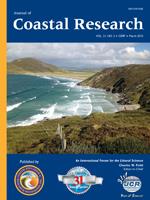Amos, C.L.; Martino, S.; Sutherland, T.F., and Al Rashidi, T., 2015. Sea surface temperature trends in the coastal zone of British Columbia, Canada.
Coastal sea surface temperature (SST), measured daily at the British Columbia (BC) Lighthouse network of stations, has been analyzed in this paper. A network of 14 of the 27 stations had (near) continuous data sets. These stations were clustered previously into exposed (northern/outer) and sheltered (southern/inner) sites. SST trends, evaluated between 1973 and 2010, show that the temperature contrast between these clusters is becoming greater: The northern/exposed stations are strongly influenced by interdecadal (Pacific Decadal oscillation [PDO]) and multidecadal oscillations in the north Pacific that are coherent with HadISST1.1 data for the region. There is no statistically significant warming trend for this region. The stations in the Strait of Georgia are much less influenced by the PDO and show a statistically significant mean increase in SST of up to 0.56°C/decade (Anomaly 1). This is higher than the global average and contrasts markedly with the trends from the northern stations. The warming trends of the southern stations are significant at all months of the year but are most evident during summer (July–September). The summertime anomalies in temperature at Active Pass are significantly correlated (p < 0.001) with the temperature of the Fraser River water. Temperature differences between the Strait of Georgia and the outer shelf (Anomaly 2) are increasing in time; this is particularly evident since 2000. Monthly averaged MODIS satellite data (4×4-km resolution) show that trends in SST at two selected sites in the Strait of Georgia are very similar to the BC Lighthouse measurements and support the spatial extrapolation of the Lighthouse measurements. At present rates of SST rise, the southern coastal waters of BC will be about 3°C warmer by the end of the 21st century.





